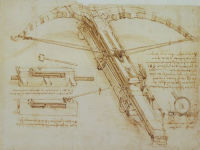Forces of Nature Click on the thumbnails to explore the trail
Read more about this trail (expand)
“Force”, the invisible agent of nature that provides all living things with motion, was a major obsession for Leonardo - the movement of turbulent water, curling hair and leaves that grow in swirling curves were all manifestations of the same natural force. In order to convey a sense of inherent energy in works of art and engineering, such phenomena must be fully understood

- Enlarge
- Zoom & explore
- Fol 149rb - Giant crossbow © Biblioteca Ambrosiana - Auth. No Int 40/05
Codex Atlanticus 1478-1518
As well as inventing “instruments of war” Leonardo sought to improve existing weapons. This design is based on a traditional crossbow. There are minor improvements in terms of its design but the greatest innovation is its gigantic scale.
Leonardo describes his crossbow as 42 braccia long, that is about 24 metres. The bow-arms are comprised of laminated sections lashed together for maximum flexibility. On the left are designs for alternative mechanisms to draw back the bow-string; above is a method involving striking a pin with a hammer and below, one that involves tripping a latch with a lever.
The giant crossbow is based on the idea that the force of thrust is directly proportional to its scale, as proposed by Aristotle. Leonardo asks “whether if an arrow is shot from a crossbow four hundred braccia, a crossbow in the same proportions but of four times the forces and size will not send the arrow four times as far”.
Later, having gained an increased awareness of the complexities of the issue through “experience”, Leonardo realised that the matter was infinitely more complicated than he had thought.
In Leonardo's words
If a force moves a body in a certain time over a certain distance, it is not necessary that this power move twice its weight in twice this time over twice the distance, because it might be that this force might not be sufficient to move the mobile object.
The Codex Atlanticus is the largest collection of Leonardo’s papers ever assembled, which was originally put together by the sculptor Pompeo Leoni. It takes its name from its large size, being comparable to an atlas.
The Codex Atlanticus reflects every aspect of Leonardo’s interests, including mechanical science, mathematics, astronomy, geography, botany chemistry and anatomy. The drawings represent a broad time-span and are varied in type. Studies relating to painting, sculptural, architectural and engineering projects are also included, such as the Adoration of the Magi altarpiece, the Sforza equestrian monument, and the dome of Milan Cathedral.
The manuscript is now arranged in 12 volumes, comprising of over 1100 miscellaneous drawings and fragments by Leonardo.
- Medium Pen and ink on paper
- Size 61 x 44 cm
- Location Biblioteca Ambrosiana











